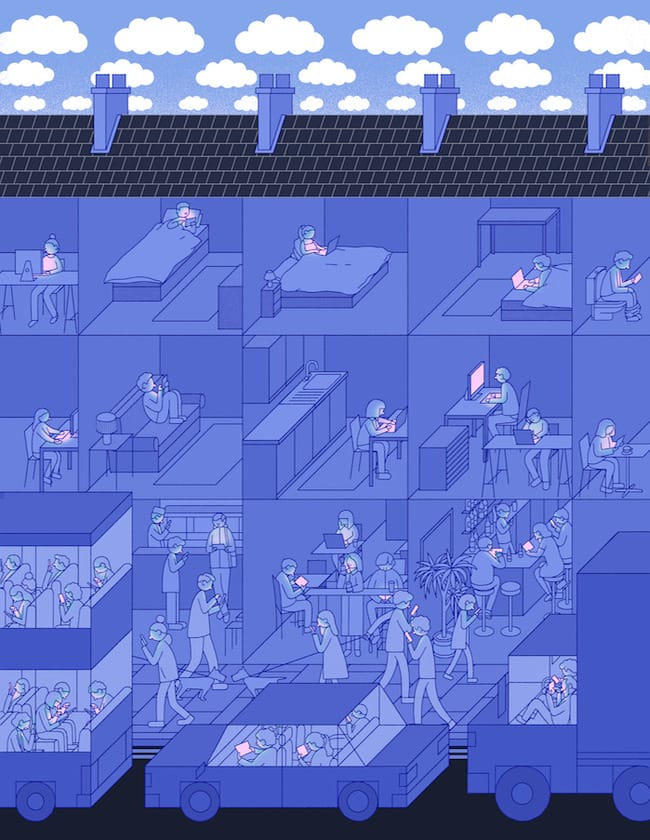Casual Texts
Digital dating apps are radically changing the way we approach potential partners. Who needs a wingman when you've got a phone?

In the seminal 1998 rom-com, You’ve Got Mail, the Meg Ryan character is too ashamed to look co-lead Tom Hanks in the eyes as she confesses that she’s developed feelings for a man she’s been anonymously emailing. Of course, Meg has yet to find out that that man is Tom Hanks – but that’s just the kind of romantic hi-jinks people got themselves into in pre-9/11, sepia-toned New York.
Fifteen years on, the landscape has changed dramatically. A week struggles to go by without a new weapon being added to the digital arsenal of the lonely singleton, from the Tinder revolution – two million Americans “matched” on the app every day – to an ever-growing collection of niche services that specialise in helping just about anyone to meet anyone. There’s hope for us all.
But what does digital dating offer that its offline counterpart can’t? According to Dr Paul Eastwick of the Attraction and Relationships Research Lab at the University of Texas the key advantage is how much it boosts the number of people you have access to. “People use online dating services to gain access to potential partners that they never would have had a chance to meet otherwise.”
Compared to its offline counterpart, digital dating also requires significantly less effort. You can now flirt outrageously from the sofa, in pyjamas, as you wolf down last night’s pizza. “It’s deemed convenient. Something to be done from the comfort of home,” says Paula Migliardi, research co-ordinator at the Sexuality Education Resource Centre in Manitoba. However, this convenience, combined with the increased number of people in the “pool”, means the rate at which people must approve or dismiss potential partners also rockets.
The negative side of the ‘appification’ [of dating] is that it tends to become more superficial. We spend less time getting a match/date and therefore pay less attention to the ones we do get. It would be logical, then, to assume that the vast number of potential hook-ups, as with financial inflation, cheapens the value of each interaction. With so many fish in the sea, is catching just one of them that big a deal any longer? “The negative side of the ‘appification’ [of dating] is that it tends to become more superficial. We spend less time getting a match/date and therefore pay less attention to the ones we do get,” says Olle Morin, founder and CEO of Swedish event-centric dating service Mazily. “Easy come, easy go.”
Another interesting feature of the digitisation of romance is the necessity to be up-front about yourself from the start. Where you’re from, what you do, your interests, hobbies and romantic intentions are staples on most dating profiles. Is the mystery dying? Ellen Fein and Sherrie Schneider, co-authors of dating advice books <The Rules>and <Not Your Mother’s Rules>,are concerned. “Most apps encourage instant connections, hook-ups endless text chats – the very opposite of slow and steady, successful courtship,” they say. “Too much, too soon is not good for dating.”
However, perhaps these are just teething problems. Are more people and a more efficient way of knowing you’re both on the same page really such bad things? Surely they just streamline the whole process. You still get to be worried about having spinach stuck in your teeth, getting on with their friends or whether they noticed that you just did a snort-laugh.
Once two people have met and hit it off, there’s not a great deal that an app can do, or perhaps even needs to do. Justin Mateen, Tinder’s co-founder and CMO, feels that, overall, the change hasn’t been that dramatic. Dating apps simply make the meeting process a smoother ride. “Meeting someone on Tinder is no different than meeting someone at a coffee shop – Tinder is just a more efficient solution,” Mateen says. “People will still go to bars – but rather than trying to meet someone at the bar, they will meet up with someone they have been introduced to via Tinder.” So perhaps all that’s really changed is how we meet, not why we meet. As Mazily’s Olle Morin says: “Love is still love.”


